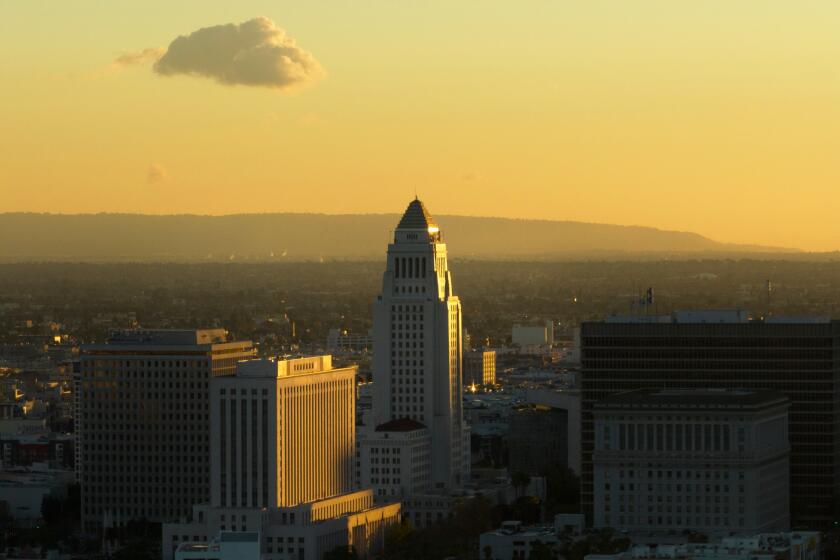Polluted Tijuana River gets more attention, but anxious residents want more urgency

- Share via
Rain is coming in south San Diego, which means higher water levels in the polluted Tijuana River — and, potentially, even worse air quality.
Now, residents worry that the home air filters newly provided by San Diego County won’t be enough to curb the noxious air from the rising river.
And despite increased federal and state attention in recent weeks, local officials and residents say that solutions are still elusive and distant in the wake of the November elections and Gov. Gavin Newsom’s refusal to declare a state of emergency over the situation.
Last month, Newsom visited the decrepit facilities at the South Bay International Wastewater Treatment Plant in San Diego and the refurbished San Antonio de los Buenos plant in Baja California for the first time.
After years of deferred maintenance, the plant in San Diego received an additional $103 million in the 2024 federal budget for repairs that will take years. The Baja plant is expected to start processing sewage soon, and once both plants are online and fully operational, sewage flows are expected to be reduced by 90% when combined with other measures.
Other federal agencies are also investigating the health concerns of nearby residents who have been suffering respiratory illnesses and unexplained stomach bugs. The Centers for Disease Control and Prevention arrived last month to conduct a health survey. Local officials and more than 500 residents have signed a petition asking the Environmental Protection Agency to declare the river a Superfund site and look into the presence of hazardous waste in the riverbed.
“Thanks to our partnership with international, federal, and local partners, we are making real progress,” Newsom said in a statement last month after his visit.
For its part, the county Board of Supervisors voted last month to purchase $2.7 million worth of air purifiers for residents, with the money ultimately coming from the California Air Resources Board.
Unanswered calls for a state of emergency
Some critics argue that the politicians haven’t acted with the necessary sense of urgency. Newsom met with Baja Gov. Marina del Pilar Ávila Olmeda, San Diego County Supervisor Nora Vargas and the International Boundary Waste and Water Commission, but local officials and residents felt snubbed.
“It feels like it was just a photo op,” said Marcus Bush, a council member for National City and a member of the Air Pollution Control District who signed the petition to the EPA. No San Diego County mayors or media outlets were invited to Newsom’s news briefing; when asked, the governor’s office offered no explanation.
“I would like to give our governor the benefit of the doubt,” Bush said, but added, “Why aren’t you taking calls or info?” He wondered aloud whether Newsom was dodging questions about his refusal to declare a state of emergency for the region.

All 18 San Diego County mayors signed a letter this year asking Newsom to declare a state of emergency. The California Coastal Commission also voted unanimously to ask the Biden administration to declare a federal state of emergency, but under federal law, such requests must come from the governor. Newsom has rebuffed those entreaties, and the White House seems no closer to making any significant moves forward.
In letters addressing the California Coastal Commission and mayors of San Diego County, Newsom’s office asserted that declaring a federal state of emergency would not accelerate the repairs needed at the sewage plant. The office also said that it did not consider the situation at the river to fit the definition of a natural disaster under federal law.
Residents have argued that a state of emergency could bring the U.S. Army Corps of Engineers to clean up and divert the river. Last year, heavy rainstorms washed into the river thousands of tons of debris that took nearly five months to clear and broke several pumps in the sewage system. Some have asked for more efficient trash skimmers that could help prevent waste from clogging the treatment plant.
“Everyone agrees that raw sewage in a river is an environmental and health emergency in crisis, but [Newsom and Vargas] are also actively doing things that undermine the emergency,” Bush said.
The Superfund split
Muddying matters further, the county supervisors voted last month to delay consideration of a petition asking the EPA to declare the river a Superfund site. Vargas, who represents the south San Diego district most affected by the noxious odors, voted in favor of the delay.
The petition was introduced by Supervisor Terra Lawson-Remer, who represents the area along the coast just north of the Tijuana River’s mouth. After the vote, Lawson-Remer joined other local officials to file the petition anyway.
“I moved forward because I think it’s urgent,” she said in an interview. It “would be nice for the Board of Supervisors as a whole to act, but it’s not necessary.”
In the board meeting last month, Lawson-Remer said she was concerned about more pollutants in the river than just sewage. Toxic chemicals and heavy metals have been detected that could be leaching into the sediment — something local officials are not equipped to clean up on their own. A petition is the first step in a lengthy process that could take years, even if the EPA decides the river is eligible for a Superfund designation.
Vargas did not agree to be interviewed. But in the Board Meeting and in public statements, she cited concerns that moving too hastily to petition the EPA could negatively affect property values and local businesses.
The Voice of San Diego news site reported that Vargas voted against the EPA petition out of concern that a Superfund designation could halt her project to clean up the South Bay to create parks for underserved communities.
“I support the spirit of this board letter,” Vargas said last month. But “this has the potential to delay local efforts already in progress and negatively affect the limited recreational space that we already have in South County.”
The board voted voted 3 to 2 to extend consideration of the petition by 90 days and have the county gather feedback and information.
Lawson-Remer said the reasons Vargas cited for the delay don’t hold water. “The health of our families and health of our children is by far the No. 1 concern,” she said. “Property values are secondary.”
An uncertain future
Imperial Beach Mayor Paloma Aguirre has been to the White House twice to speak with Brenda Mallory, the chair of President Biden’s Council on Environmental Quality, to ask for assistance. She plans to make one last plea in person next month.
President-elect Donald Trump previously authorized $300 million to stop the cross-border pollution as part of the U.S-Mexico-Canada trade agreement in 2020. But Trump’s vow to cut federal budgets when he takes office in 2025 has Aguirre concerned about a reduction in disaster relief funding. Lee Zeldin, Trump’s choice to lead the EPA, is also expected to scale back regulations.
“If he dismantles the EPA ... good luck to all of us, because I don’t know what the strategy will be,” Aguirre said.
A damaged local economy
Meanwhile, residents say that the pollution has already hurt the local economy. Visitors to Imperial Beach have steadily fallen with beach closures due to the contamination, according to numbers provided by the mayor’s office — to just under 700,000 in 2023 from 2.1 million in 2018.
Local restaurateur Gabriel Uribe has run Baja Oyster and Sushi Bar for 25 years in Imperial Beach, a few miles from his ranch, where he also hosts outdoor parties for quinceaneras and graduations.
Guests have left Uribe’s parties early because the air reeks of rotten eggs, he said, and the air filters from the county won’t solve all his problems. “That is like just a Band-Aid on a wound that needs stitching,” he added.
Uribe, who signed the EPA petition, worries that his property’s value could be affected if a Superfund site is declared, or even that his property could be taken through eminent domain. But he wants officials to act urgently to address his health concerns.
“My chest is wheezing. I have an irregular heartbeat,” said Uribe, who’s gone to the emergency room because he couldn’t breathe.
Deborah Vance, who runs a real estate agency in Imperial Beach, said her business has already been affected by the pollution as prospective buyers have been unwilling to purchase property in the city. She struggled to sell four listings in Imperial Beach this last year, a slowdown that had been unheard of in the past.
“It’s beyond impactful,” she said of the pollution. All of the agents who worked with her, she added, have quit or moved on. “It’s devastating.”







